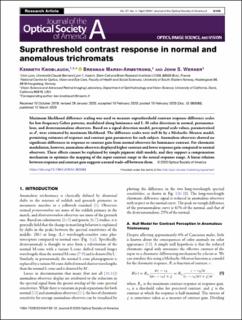| dc.contributor.author | Knoblauch, Kenneth | |
| dc.contributor.author | Werner, John S. | |
| dc.contributor.author | Marsh-Armstrong, Brennan | |
| dc.date.accessioned | 2020-03-16T09:19:38Z | |
| dc.date.available | 2020-03-16T09:19:38Z | |
| dc.date.created | 2020-03-11T11:21:36Z | |
| dc.date.issued | 2020 | |
| dc.identifier.citation | Journal of the Optical Society of America A. 2020, 37 (4), A133-A144. | en_US |
| dc.identifier.issn | 0740-3232 | |
| dc.identifier.uri | https://hdl.handle.net/11250/2646880 | |
| dc.description | OSA is aware that some authors, as a condition of their funding, must publish their work under a Creative Commons license. We therefore offer a CC BY license for authors who indicate that their work is funded by agencies that we have confirmed have this requirement. Authors must enter their funder(s) during the manuscript submission process. At that point, if appropriate, the CC BY license option will be available to select for an additional fee. | en_US |
| dc.description.abstract | Maximum likelihood difference scaling was used to measure suprathreshold contrast response difference scales for low-frequency Gabor patterns, modulated along luminance and L–M color directions in normal, protanomalous, and deuteranomalous observers. Based on a signal-detection model, perceptual scale values, parameterized as 𝑑�′, were estimated by maximum likelihood. The difference scales were well fit by a Michaelis–Menten model, permitting estimates of response and contrast gain parameters for each subject. Anomalous observers showed no significant differences in response or contrast gain from normal observers for luminance contrast. For chromatic modulation, however, anomalous observers displayed higher contrast and lower response gain compared to normal observers. These effects cannot be explained by simple pigment shift models, and they support a compensation mechanism to optimize the mapping of the input contrast range to the neural response range. A linear relation between response and contrast gain suggests a neural trade-off between them. | en_US |
| dc.description.sponsorship | National Eye Institute; Agence Nationale de la Recherche | en_US |
| dc.language.iso | eng | en_US |
| dc.rights | Navngivelse 4.0 Internasjonal | * |
| dc.rights.uri | http://creativecommons.org/licenses/by/4.0/deed.no | * |
| dc.title | Suprathreshold contrast response in normal and anomalous trichromats | en_US |
| dc.type | Journal article | en_US |
| dc.description.version | publishedVersion | en_US |
| dc.rights.holder | © 2020 Optical Society of America under the terms of the OSA Open Access Publishing Agreement | en_US |
| dc.source.pagenumber | A133-A144 | en_US |
| dc.source.volume | 37 | en_US |
| dc.source.journal | Journal of the Optical Society of America A | en_US |
| dc.source.issue | 4 | en_US |
| dc.identifier.doi | https://doi.org/10.1364/JOSAA.380088 | |
| dc.identifier.cristin | 1801116 | |
| cristin.ispublished | true | |
| cristin.fulltext | original | |
| cristin.qualitycode | 0 | |

